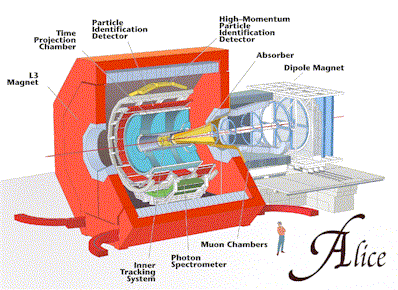 ALICE -
A Large
Ion
Collider E
xperiment
ALICE -
A Large
Ion
Collider E
xperiment

The idea of ALICE | Our ALICE grup
| Current tasks |
Important events

The idea of ALICE Experiment
 ALICE
- will be one of the world largest
physics experiments. The first measurements are planned for the year 2005 and will
be performed at CERN, - European Laboratory for
Particle Physics, with the participation of hundreds of physicists form different world
laboratories. The colliding beams of Large Hadron Collider will give the CMS energy of
5400 GeV per nucleon.
ALICE
- will be one of the world largest
physics experiments. The first measurements are planned for the year 2005 and will
be performed at CERN, - European Laboratory for
Particle Physics, with the participation of hundreds of physicists form different world
laboratories. The colliding beams of Large Hadron Collider will give the CMS energy of
5400 GeV per nucleon.
The main goal of this experiment is to search for the phase transition from hadronic
to quark-gluon plasma state of matter. This transition is possible only for the extremal
values of nuclear matter temperatures and densities. It corresponds also to the first instants
of the creation of Universe in the frame of the Big Bang hypothesis.
The signatures of the phase transitions can be observed in the characteristics of
particles emitted in the results of heavy-ion collisions. The number of particles emitted
in one collision is of the order of tens of thousands. Identification and measurement of
energies of all the particles is an
extremely difficult task and the challenge not only for physicists but also for the modern
electronics, informatics, mechanics etc. In the ALICE experiment the size of
data stored in 1 second will exceed 1 GB.

ALICE group form Faculty of Physics, Warsaw
University of Technology
Since September 1998 - the group from Faculty of Physics, Warsaw University of
Technology is a member of the ALICE Collaboration.
The Group Structure
This scheme I have presented during the Collaboration Board meeting 26 November
1998.


The current tasks
- "Space-time development- Momentum correlations" - The group
is participating in the preparation of Physics Performance Report, point 6.3
on close velocity correlations including the HBT correlations, Final
state interactions etc. I am a convener of the corresponding working group in
the frame of ALICE.
- Data-Base of the Inner Tracking System - Wiktor Peryt is responsible
for the preparation of the database for the ITS detector. A team from
Warsaw together with the members of other laboratories are cooperating in this
work. The most intensive collaboration is now with the laboratories from
Strasbourg and from Nantes.
- Construction of the Silicon Strip Detector - is related to our
participation in the STAR experiment and the close cooperation with the Nantes
and Strasbourg groups.
 IMPOTRANT
EVENTS
IMPOTRANT
EVENTS
ALICE nad Heavy
ion Physics
in Warsaw
11-15 October 2000
In October 2000 at the Faculty of Physics Warsaw
University of Technology five days were a real time of ALICE experiment in Warsaw. 15
persons - coordinators of different research programs in the frame of ALICE have
presented in Warsaw the current status of developments of different scientific
and technical topics. 24 reports, and the seminar at the Physics Faculty by
three speakers - professors: Guy Paic, Barbara Erazmus and Jean-Pierre Coffin,
were arranged. During the round table discussion at the end of the meeting the
main directions of future cooperation were drawn. The meeting with the Dean of
the Faculty of Physics Prof. F. Krok and with the Vce Deans: professors: R.
Bacewicz and J. Garbarczyk were very fruitful to establish the role of the
participation of our group at ALICE in the research activity of the Faculty. A
meeting with the Vce Rector of Warsaw University of Technology Prof. M. Mojski
stressed the role of fundamental research in the activity of our School and the
role of technology development in the realization of the ALICE experiment. There
were a lot of discussions on the various problems of heavy ion physics, ALICE
experiment and the organization of our cooperation.
The meeting was finished by the excursion to Cracow - ancient capital of
Poland, and to the salt mine of Wieliczka.
The organizers are very grateful to all the participant for their
presentations, their discussions with our small local heavy ion community, for
their openness to the cooperation with our students and PhD students which enter
this extremely interesting but also very difficult domain of physics. Special
thanks to Federico Carminati, Roberto Barbera and Andreas Morsch for the
tutorial of AliRoot and for the explanation of the ALICE software
infrastructure. The importance of the meeting was shown by the presence and the organization
of the concluding discussion by the deputy spokesman of ALICE Paolo
Gubellino.
Thanks Paolo, thanks to all participants. We expect that this meeting was the
first but not the only meeting in Warsaw and we will see our friends from the
ALICE experiment again and soon in at our new Faculty of Physics in Warsaw.
![]()
 ALICE
- will be one of the world largest
physics experiments. The first measurements are planned for the year 2005 and will
be performed at CERN, - European Laboratory for
Particle Physics, with the participation of hundreds of physicists form different world
laboratories. The colliding beams of Large Hadron Collider will give the CMS energy of
5400 GeV per nucleon.
ALICE
- will be one of the world largest
physics experiments. The first measurements are planned for the year 2005 and will
be performed at CERN, - European Laboratory for
Particle Physics, with the participation of hundreds of physicists form different world
laboratories. The colliding beams of Large Hadron Collider will give the CMS energy of
5400 GeV per nucleon. ![]()
